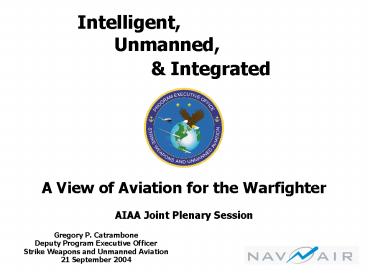Intelligent, Unmanned, - PowerPoint PPT Presentation
1 / 21
Title: Intelligent, Unmanned,
1
Intelligent, Unmanned, Integrated
A View of Aviation for the WarfighterAIAA Joint
Plenary Session
Gregory P. Catrambone Deputy Program Executive
Officer Strike Weapons and Unmanned Aviation 21
September 2004
2
Unmanned AviationIts come a long way . . . but
just barely begun
Past
Present
Future
3
JV 2010/2020 Implications
Surveillance
Natural Disaster
Terrorism
Show of force
Strike and Raids
Insurgency
Joint Vision 2010
Revolution
Civil War
Limited War
Theater War
General War
- Joint forces to rapidly respond across the
spectrum of conflict - Ability to leverage technologies enabling precise
force application - High degree of situational awareness at all
command levels - Better and faster decisions enabling high tempo
operations - Joint/coalition force interoperability
Information and knowledge intensive
4
Sea Power 21
Projecting global Defensive assurance
Linking naval, joint, and national information
grids to achieve robust SA and knowledge
management
Projecting precise and persistent Offensive power
Projecting Joint operational independence (provide
enhanced support for Joint forces afloat and
ashore)
- Organized around Expeditionary Strike Forces
(ESF) - Carrier Strike Groups (CSG) - CVBG centered
- Expeditionary Strike Groups (ESG) - ARG centered
(surface combatants) - Surface Action Groups (SAG) - Surface combatant
centered - Unit level forces
Agile, responsive and self sustaining sea-based
forces
5
Expeditionary Maneuver Warfare(Marine Corps
Capstone Concept)
- Describes the Expeditionary Advantage
combination of maneuver warfare, expeditionary
culture and task organization of Marine Air
Ground Task Forces (MAGTFs) - Maneuver Warfare
- Gradual shift from quantitative (mass and volume)
to qualitative (speed, stealth, precision and
sustainability) characteristics - Proactive thought and high tempo operations
- Decentralized decision-making
- Expeditionary Culture
- Austere environment
- Forward-deployed and forward-based
- Full range of response options
- Joint/combined force interoperability
- MAGTFs
- Scalable, tailored combined arms teams
- Joint force enabler
Flexible, adaptive force packages able to rapidly
respond across the contingency spectrum
6
Future Mission Environment
- Asymmetrical non-linear, rural and urban
- Increasingly complex non-combatants and ROE
- Employment of new and advanced technologies by
friends and foes alike - Requires operational and tactical agility and
mobility - Each platform/individual viewed as a node in
developing a Common Operational Picture (COP) - Precision operations a way of life
- Desire to maintain high operational tempo
- High expectations
- Win quickly and decisively with minimal losses
and collateral damage
Stresses greater Situational Awareness leading to
increased Combat Effectiveness - at every level
7
Naval UAV Focus
- Long-Dwell Standoff ISR UAV
- Penetrating Surveillance/Strike UAV
- Tactical Surveillance Targeting UAV
- Supporting Systems
8
Civil ApplicationsExpanding the realm
9
Open Architectures and StandardsThe Key to
Mission Flexibility
Vehicles
Weapon Interface Standards
Payload Interface Standards
Control Data Standards
Data Link
Data Distribution Interfaces
Control Systems
10
NATO Vision of Interoperability
11
Unmanned Aviation Systems
Data Link STANAG 7085
Payload Data STANAG 7023 Primary Imagery STANAG
4545 Secondary Imagery STANGA 4607 GMTI Radar
Data STANAG 4609 Motion Imagery
Payload Data
Air Vehicle Payload C2
Focus of STANAG 4586
Ground Control Station
Imagery
Digital Messages
Tactical Messages STANAG 5500 ADatP-3
C4I Nodes
12
Unmanned AviationMore than a stand alone asset
1
Other Manned Aviation
Other UAVs
Vehicles
Data Link
Data Link
Other Surface Nodes
GCS
13
Unmanned AviationPart of Integrated Warfare
Network Centric Warfare
Observe
Imagery Systems
Precision Targeting
Weapons
Sensors / Vehicles
Weapons Control
14
Unmanned Aviation Part of the Mission Force
15
Systems Viewbeneath the lightning bolts
16
Intelligent SystemsA Key to Effectiveness
- Complementary sensor coverage
- FOR- 270 Threshold, 360 Objective
- ESM has longest detect with active targets
- Radar hole under air vehicle due to radar
minimum range - EO/IR covers area under air vehicle
- Maximize sensor overlap essential for positive ID
- Ability to see forward quarter important,
especially in tight quarters - Adaptive and Intelligent Sensor and Flight
Control to perform and complete mission
17
Capability Countsbut warfighters need the whole
package
Reliability
EFFECTIVE
Interoperability
Ease of Use
Technology
Capability
CONOPS
Safety
SUITABLE
Maintainability
Training
18
Some Unmanned Aviation Challenges
- Technology Driven
- Miniaturized Lightweight and Low Cost Payloads
- Vehicle Survivability
- High Capacity Jam Resistant Data Links Improved
Data Reduction - Optimized Propulsion
- Autonomous and Collaborative Operations
Technologies - Philosophy Technology Dependent
- Demos, Experimentation, and CONOPS
- Airspace Management
- Architecture and Standards - Interoperable
Control Stations - Plug and Play Payloads
19
Providing for the WarfighterA partnership effort
Operational Leadership
REQUIREMENTS RISKS
Warfighter
RESOURCES
PROVIDERS
ACQUISITION ST
SPONSORS
20
What Can Industry Do?
- Participate in the Process
- Seek strategies for faster fielding
- Develop integrated solutions
- Partner in innovation efforts
- Convert information into knowledge
- Develop FORCEnet integration
- Employ open architecture systems
- Develop technical solutions and improvements
- Reliability, Maintainability, Sustainability,
etc. - Maintain open and effective communications
Support the Warfighter!
21
Unmanned Aviation
Intelligent
Integrated
- The Future is bright
- the Horizons are endless































